This article may need to be rewritten to comply with Wikipedia's quality standards.(January 2023) |
Wavetable synthesis is a sound synthesis technique used to create quasi-periodic waveforms often used in the production of musical tones or notes.
This article may need to be rewritten to comply with Wikipedia's quality standards.(January 2023) |
Wavetable synthesis is a sound synthesis technique used to create quasi-periodic waveforms often used in the production of musical tones or notes.
Wavetable synthesis was invented by Max Mathews in 1958 as part of MUSIC II. MUSIC II “had four-voice polyphony and was capable of generating sixteen wave shapes via the introduction of a wavetable oscillator.” [1]
Hal Chamberlin discussed wavetable synthesis in Byte's September 1977 issue. [2] Wolfgang Palm of Palm Products GmbH (PPG) developed his version in the late 1970s [3] and published it in 1979. [4] The technique has since been used as the primary synthesis method in synthesizers built by PPG and Waldorf Music and as an auxiliary synthesis method by Ensoniq and Access. It is currently used in hardware synthesizers from Waldorf Music and in software synthesizers for PCs and tablets, including apps offered by PPG and Waldorf, among others.
It was also independently developed by Michael McNabb, who used it in his 1978 composition Dreamsong . [5] [6]
Wavetable synthesis is fundamentally based on periodic reproduction of multiple arbitrary, single-cycle waveforms. [7] In wavetable synthesis, some method is employed to vary or modulate the selected waveform in the wavetable. The position in the wavetable selects the single cycle waveform. Digital interpolation between adjacent waveforms allows for dynamic and smooth changes of the timbre of the tone produced. Sweeping the wavetable in either direction can be controlled in a number of ways, for example, by use of an LFO, envelope, pressure or velocity.
Many wavetables used in PPG and Ensoniq synthesizers can simulate the methods used by analog synthesizers, such as pulse-width modulation by utilising a number of square waves of different duty cycles. In this way, when the wavetable is swept, the duty cycle of the pulse wave will appear to change over time. As the early Ensoniq wavetable synthesizers had non resonant filters (the PPG Wave synthesizers used analogue Curtis resonant filters), some wavetables contained highly resonant waveforms to overcome this limitation of the filters.
In 1992, with the introduction of the Creative Labs Sound Blaster 16 the term "wavetable" [8] started to be (incorrectly) applied as a marketing term to their sound card. However, these sound cards did not employ any form of wavetable synthesis, [9] but rather PCM samples and FM synthesis.
S&S (Sample and Synthesis) and Digital Wave Synthesis was the main method of sound synthesis utilised by digital synthesizers starting in the mid 1980s with synthesizers such as Sequential Circuits Prophet VS, Korg DW6000/8000 (DW standing for Digital Wave), Roland D50 and Korg M1 through to current synthesizers.
Ableton addressed some confusion in an article: [10]
Wait, so isn't this just sampled synthesis? Let's pause here to address a common confusion. While sampled synthesis involves the use of a static digital sample, wavetable synthesis allows for the (optional) evolution of a waveform; this is to say, while wavetable synths can sound like sampled synthesis, the evolving option (which is enabled by default on most classic wavetable sounds) differentiates it.
Often they now have displays showing a real time 3d graphs of the wave table being played back with the current waveform highlighted which is the signature feature common in modern wavetable synths.
The creation of new wavetables was previously a difficult process unless supported by specialized editing facilities and (near) real-time playback of edited wavetables on the synthesizer. Such editors often required the use of extra hardware devices like the PPG Waveterm or were only present in expensive models like the Waldorf WAVE. More commonly, pre-computed wavetables could be added via memory cards or sent to the synthesizer via MIDI. Today, wavetables can be created more easily by software and auditioned directly on a computer. Since all waveforms used in wavetable synthesis are periodic, the time-domain and frequency-domain representation are exact equivalents of each other and both can be used simultaneously to define waveforms and wavetables.
During playback, the sound produced can be harmonically changed by moving to another point in the wavetable, usually under the control of an envelope generator or low frequency oscillator but frequently by any number of modulators (matrix modulation). Doing this modifies the harmonic content of the output wave in real time, producing sounds that can imitate acoustic instruments or be totally abstract, which is where this method of sound creation excels. The technique is especially useful for evolving synth pads, where the sound changes slowly over time.
It is often necessary to 'audition' each position in a wavetable and to scan through it, forwards and backwards, in order to make good use of it, though selecting random wavetables, start positions, end positions and directions of scan can also produce satisfying musical results. It is worth noting that most wavetable synthesizers also employ other synthesis methods to further shape the output waveform, such as subtractive synthesis (filters), phase modulation, frequency modulation and AM (ring) modulation.
This section may need to be rewritten to comply with Wikipedia's quality standards.(August 2020) |
On Csound, it is called f-table (function table), and used for various purposes including: wavetable-lookup synthesis, waveshaping, MIDI note mapping, and storing ordered pitch-class sets. [11]
Table-lookup synthesis [12] (or Wavetable-lookup synthesis [13] ) ( Roads 1996 ) is a class of sound synthesis methods using the waveform tables by table-lookup, called "table-lookup oscillator" technique. The length of waveforms or samples may be varied by each sound synthesis method, from a single-cycle up to several minutes.
The term "waveform table" (or "wave shape table" as equivalent) is often abbreviated to "wavetable", [14] and its derived term "wavetable oscillator" [15] seems to be almost the same as "table-lookup oscillator" mentioned above, although the word "wave" (or "waveform", "wave shape") may possibly imply a nuance of single-cycle waveform.
However, the derived term "wavetable synthesis" seems slightly confused by the later developments of derived algorithm.
On the above four terminologies for the classes of sound synthesis methods —i.e., (1) Wavetable synthesis, (2) Wavetable-modification algorithm, (3) Multiple wavetable synthesis, and (4) Sample-based synthesis— if these had been appropriately used to distinguish each other, any confusions could be avoided, but it seems failed historically. In the 1990s at the latest, several influential sample-based synthesis products were marketed under the trade names similar to "wavetable synthesis" (including Gravis Ultrasound wavetable card, Creative Wave Blaster wavetable daughterboard, and Microsoft GS Wavetable SW Synth), and these confusions have further affected industry standards (including MPEG-4 Structured Audio algorithmic and wavetable synthesis, [23] and AC97 optional hw acceleration wavetable synth [24] ). In the mid-2000s, confusion in terminology cropped up yet-again. A subclass of generic wavetable synthesis, i.e. McNabb and Palm's multiple wavetable synthesis, tends to be erroneously referred as if it was a generic class of whole wavetable synthesis family, exclusively. [25]
As a result, the difficulty of maintaining consistency between concepts and terminology during rapid technological development is noteworthy. For this reason the term "Table-lookup synthesis" is explained at length in this article.
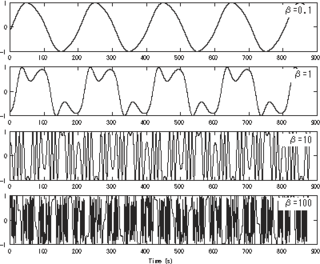
Frequency modulation synthesis is a form of sound synthesis whereby the frequency of a waveform is changed by modulating its frequency with a modulator. The (instantaneous) frequency of an oscillator is altered in accordance with the amplitude of a modulating signal.
Karplus–Strong string synthesis is a method of physical modelling synthesis that loops a short waveform through a filtered delay line to simulate the sound of a hammered or plucked string or some types of percussion.
Digital waveguide synthesis is the synthesis of audio using a digital waveguide. Digital waveguides are efficient computational models for physical media through which acoustic waves propagate. For this reason, digital waveguides constitute a major part of most modern physical modeling synthesizers.
A rompler is an electronic musical instrument that plays pre-fabricated sounds based on audio samples. The term rompler is a blend of the terms ROM and sampler. In contrast to samplers, romplers do not record audio. Both may have additional sound editing features, such as layering several waveforms and modulation with ADSR envelopes, filters and LFOs.
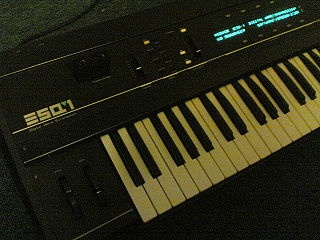
Ensoniq ESQ-1 is a 61-key, velocity sensitive, eight-note polyphonic and multitimbral synthesizer released by Ensoniq in 1985. It was marketed as a "digital wave synthesizer" but was an early Music Workstation. Although its voice generation is typically subtractive in much the same fashion as most analog synthesizers that preceded it, its oscillators are neither voltage nor "digitally controlled", but true digital oscillators, provided by a custom Ensoniq wavetable chip. The signal path includes analog resonant low-pass filters and an analog amplifier.
Phase distortion (PD) synthesis is a synthesis method introduced in 1984 by Casio in its CZ range of synthesizers. In outline, it is similar to phase modulation synthesis as championed by Yamaha Corporation, in the sense that both methods dynamically change the harmonic content of a carrier waveform by influence of another waveform (modulator) in the time domain. However, the application and results of the two methods are quite distinct.
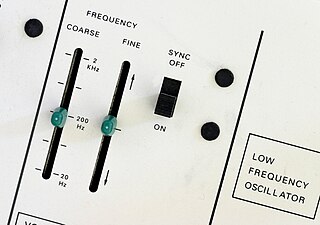
Oscillator sync is a feature in some synthesizers with two or more VCOs, DCOs, or "virtual" oscillators. As one oscillator finishes a cycle, it resets the period of another oscillator, forcing the latter to have the same base frequency. This can produce a harmonically rich sound, the timbre of which can be altered by varying the synced oscillator's frequency. A synced oscillator that resets other oscillator(s) is called the master; the oscillators which it resets are called slaves. There are two common forms of oscillator sync which appear on synthesizers: Hard Sync and Soft Sync. According to Sound on Sound journalist Gordon Reid, oscillator sync is "one of the least understood facilities on any synthesizer".
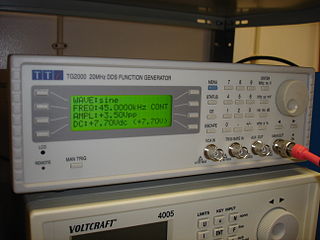
Direct digital synthesis (DDS) is a method employed by frequency synthesizers used for creating arbitrary waveforms from a single, fixed-frequency reference clock. DDS is used in applications such as signal generation, local oscillators in communication systems, function generators, mixers, modulators, sound synthesizers and as part of a digital phase-locked loop.

Waldorf Music is a German synthesizer company. They are best known for the Microwave wavetable synthesizer and Blofeld virtual analogue synthesizer.

The Access Virus is a virtual analog synthesizer made by the German company Access Music GmbH. It was first produced in 1997 and has since been upgraded frequently, with the company releasing new models about every two years. Early models include the Virus A, Virus B, and Virus C series, each available in various hardware configurations. In November 2005, the Virus TI series was released, including the 61-key Virus TI Keyboard and the 37-key Virus TI Polar. A small desktop model was released in February 2008 called the Virus TI Snow. A revision of the TI series called TI2 came out in March 2009, featuring faster digital signal processing (DSP) controllers, additional polyphony, more effects in the effect section and a slightly changed design. The Virus series also has come out with two software plugin versions: TDM for Pro Tools and VST for TC Electronic Powercore series. The term Access Virus can be used to refer to any one of these synthesizers. In 2024 Access Music discontinued the TI2.
Wavetable may refer to:

Palm Products GmbH was a manufacturer of audio synthesizers. Founded and owned by Wolfgang Palm, PPG was located in Hamburg, Germany and, for 12 years from around 1975 to 1987, manufactured an acclaimed and eclectic range of electronic musical instruments, all designed by Palm.

The Korg Wavestation is a vector synthesis synthesizer first produced in the early 1990s and later re-released as a software synthesizer in 2004. Its primary innovation was Wave Sequencing, a method of multi-timbral sound generation in which different PCM waveform data are played successively, resulting in continuously evolving sounds. The Wavestation's "Advanced Vector Synthesis" sound architecture resembled early vector synths such as the Sequential Circuits Prophet VS.

The Elektron Monomachine is a synthesizer and music sequencer by Elektron. The Monomachine was available as SFX-60 model, which is a desktop sound module, and was available as the SFX-6 model, which has a keyboard and a joystick controller. During the last quarter of 2007 Elektron released the SFX-60 MkII, which is a revision providing higher signal-to-noise ratio, a slimmer design and the ability to add user waveforms, introduced with OS 1.20 in July 2008.
Linear arithmetic synthesis, or LAsynthesis, is a means of sound synthesis invented by the Roland Corporation when they released their D-50 synthesizer in 1987.
Wolfgang Palm is a German musician and inventor who was the founder and owner of Palm Products GmbH (PPG) and the inventor and creator of various pioneering technical designs for analog and digital synthesizers. He is widely acknowledged as the father of digital synthesis and as a trendsetter in the use of computer technology in the making of electronic music.

A synthesizer is an electronic musical instrument that generates audio signals. Synthesizers typically create sounds by generating waveforms through methods including subtractive synthesis, additive synthesis and frequency modulation synthesis. These sounds may be altered by components such as filters, which cut or boost frequencies; envelopes, which control articulation, or how notes begin and end; and low-frequency oscillators, which modulate parameters such as pitch, volume, or filter characteristics affecting timbre. Synthesizers are typically played with keyboards or controlled by sequencers, software or other instruments and may be synchronized to other equipment via MIDI.

The PPG Wave is a series of synthesizers built by the German company Palm Products GmbH from 1981 to 1987.
The Nord Wave is a 49-key polyphonic synthesiser developed by Clavia. It integrates the playback and manipulation of samples into a virtual analog and FM synth engine, which is a rare combination on keyboard synthesizers.
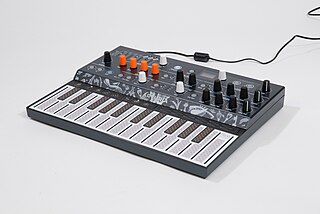
The MicroFreak is a synthesizer manufactured by French music technology company Arturia and released in 2019. Described as a "Hybrid Experimental Synthesizer", it uses 18 digital sound engines (algorithms) to synthesize raw tones. This digital oscillator is then fed into a multi-mode analog filter, giving the MicroFreak its hybrid sounds.
The samples in the wave shape table ...", "FIGURE 1 ... 16 K × 14 BIT WAVETABLE
In this section ... we will be introduce the table-lookup method for generating waveforms. This method is also called wavetable synthesis ... / Wavetable synthesis is a technique based on reading data that has been stored in blocks of contiguous computer-memory locations, called tables. This sound-synthesis technique was one of the very first software synthesis methods introduced in the MUSIC I-MUSIC V languages developed by Max Mathews at Bell Labs in the late 1950s and the early 1960s. ... / With table-lookup synthesis, it is sufficient to calculate only a single cycle of a waveform, and then store this small set of samples in the table where it serves as a template. ..."
Note: on the preceding quotation, the authors paraphrased the section title "table-lookup oscillators" as follows: "table-lookup method", "wavetable synthesis", and "table-lookup synthesis".
The oscillator generates a cycle of some waveform the appropriate number of times per second for the desired fundamental frequency. This is referred to variously as fixed-waveform synthesis, table-lookup synthesis, or wavetable synthesis.
Wavetable Synthesis: One standard synthesis technique is the wavetable synthesis algorithm. ... The wavetable-synthesis technique is very simple but rather dull musically, since it produces purely periodic tones. ... All the algorithms described in this paper produce the variation in sound by modifying the wavetable itself.
Multiple wavetable synthesis, the subject of this paper, is based on a sum of fixed waveforms or periodic basis functions with time-varying weights.
2.2 Wavetable synthesis with SASBF: The SASBF wavetable-bank format had a somewhat complex history of development. The original specification was contributed by E-Mu Systems and was based on their "SoundFont" format [15]. After integration of this component in the MPEG-4 reference software was complete, the MIDI Manufacturers Association (MMA) approached MPEG requesting that MPEG-4 SASBF be compatible with their "Downloaded Sounds" format [13]. E-Mu agreed that this compatibility was desirable, and so a new format was negotiated and designed collaboratively by all parties.
Figure 2. AC '97 System Diagram: AC '97 Digital Controller / Optional hw acceleration / SRC*, mix*, 3D positional*, wavetable synth*